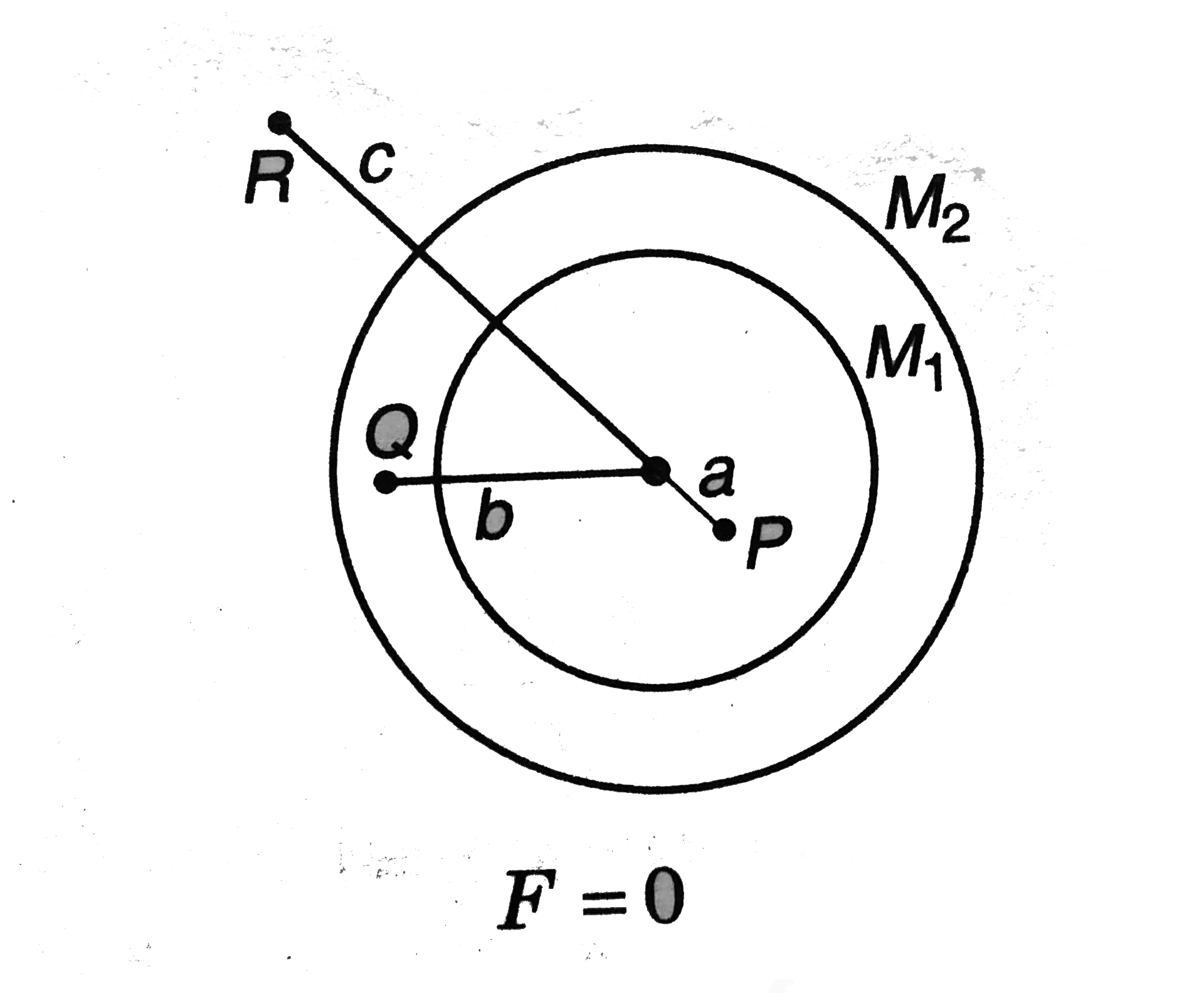Two concentric shells of masses M1 and M2 are having radii r1 and r2. Which of the following is the correct expression for the gravitational field on a mass m?

F=G(M1+M2)r2, for r<r1
F=G(M1+M2)(r2), for r<r2
F=GM2r2, for r1<r<r2
F=GM1r2, for r1<r<r2
The correct Answer is:C
Gravitational field inside a shell is zero, but for points outside it, the shell behaves as if whole of its mass is concentrated at its centre. Hence, for a point lying in between the shells there will be a field only due to the inner shell (=GM2/r2) because the point will be an external point for the inner shell but internal for the outer shell.
Topper's Solved these Questions
- GRAVITATIONBOOK - CENGAGE PHYSICSCHAPTER - GRAVITATIONEXERCISE - Multiple Correct
24 Videos
- GRAVITATIONBOOK - CENGAGE PHYSICSCHAPTER - GRAVITATIONEXERCISE - Assertion- Reasoning
13 Videos
- GRAVITATIONBOOK - CENGAGE PHYSICSCHAPTER - GRAVITATIONEXERCISE - Subjective
15 Videos
- FLUID MECHANICSBOOK - CENGAGE PHYSICSCHAPTER - FLUID MECHANICSEXERCISE - INTEGER_TYPE
1 Videos
- KINEMATICS-1BOOK - CENGAGE PHYSICSCHAPTER - KINEMATICS-1EXERCISE - Integer
9 Videos
Similar Questions
Two concentric spherical shells have masses m1andm2 and radii r1andr2(r2>r1). What is the force exerted by this system on a particle of mass m3. If it is placed at a distance r(r1<r<r2) from the centre ?
View SolutionTwo concentric shells of masses M1 and M2 are concentric as shown. Calculate the gravitational force on m due to M1 at points P,Q and R.

View Solution
Knowledge Check
Assertion : Two spherical shells have masses m1andm2. Their radii are r1andr2. Let r be the distance of a point from centre. Then gravitational field strength and gravitational potential both are equal to zero for O<r<r1

Reason : In the region r1<r<r2, gravitational field strength due to m2 is zero. But gravitational potential due to m2 is constant (but non-zero).AIf both Assertin and Reason are correct and Reason is the correct explanation of AssertionBIf both Assertion and Reason are correct but Reason is not the correct explanation of AssertionCIf Assertion is true but Reason is falseDIf Assertion is false but Reason is trueConsider three concentric shells of masses M1,M2andM3 having radii a,b and c respectively are situated as shown in

Gravitational field at a point located at Q and P isAG(M1+M2)y2,G(M1+M2)y2BG(M1+M2+M3)Y2,G(M1+M2)x2CG(M1+M2+M3)a2,GM1a2DG(M1+M2+M3)C2,GM2b2Two concentric shells of different mass m1 and m2 are having a sliding particle of mass m. The forces on the sliding at positions I,II and III are respectively
 A0,Gm1r22,G(m1+m2)mr21BGm2r22,0,Gm1r21CG(m1+m2)mr21,Gm2r22,0DG(m1+m2)mr21,G(m2)mr22,0
A0,Gm1r22,G(m1+m2)mr21BGm2r22,0,Gm1r21CG(m1+m2)mr21,Gm2r22,0DG(m1+m2)mr21,G(m2)mr22,0
Two bodies of masses m1 and m2 are placed at a distance r apart. Show that the position where the gravitational field due to them is zero, the potential is given by
−G(m1+m2+2√m1+m2)/r
View SolutionPosition vector of centre of two particles of masses m1 and m2 whose position vectors r1 and r2 then rcm?
View SolutionTwo particles of masses m1andm2 are moving in concentric circle of radii r1andr2 such that their period are same. Then the ratio of their centripetal acceleration is
View SolutionTwo bodies of masses M1 and M2, are placed at a distance R apart. Then at the position where the gravitational field due to them is zero, the gravitational potential is
View SolutionThe figure represents two concentric shells of radii R1 and R2 and masses M1 and M2 respectively. The gravitational field intensity at the point A at distance a(R1<a<R2) is

View Solution
